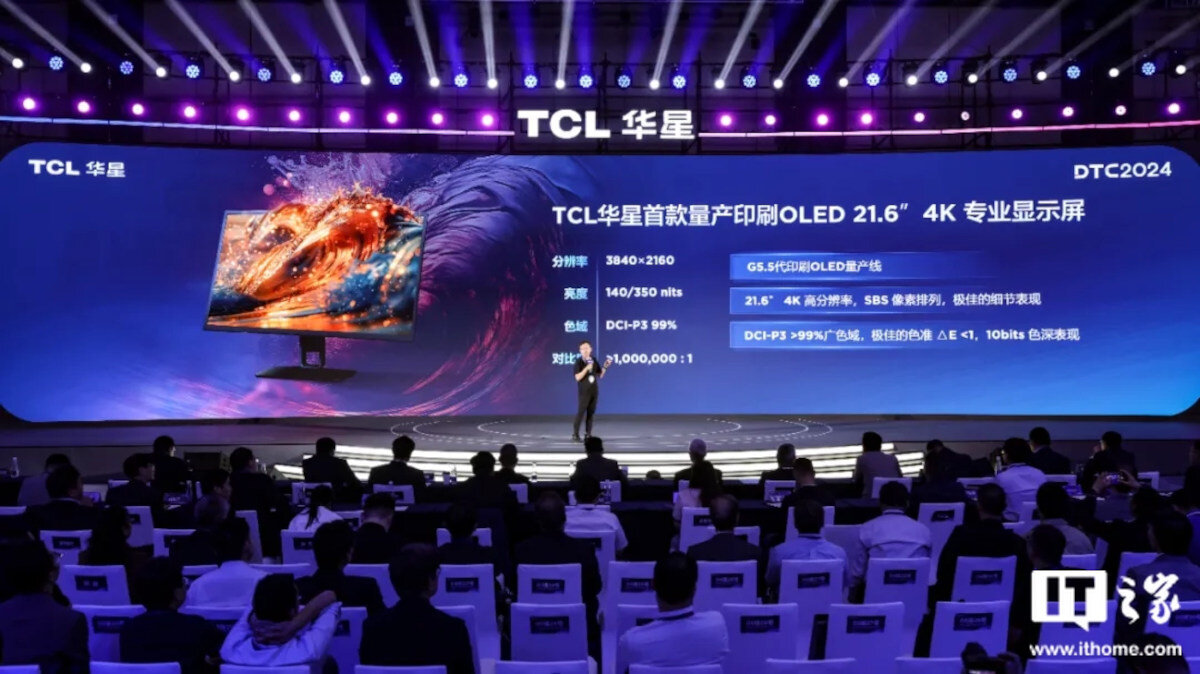OLED inkjet printing: TCL starts mass production 96 comments

Image: TCL CSOT
An inkjet printing process aims to make producing OLED displays less expensive. While the Japanese pioneer JOLED failed, the Chinese TCL is now trying: mass production has officially started. It starts with a 22-inch panel with 4K UHD for the monitors.
As reported by the OLED-Info site with information from Asia, TCL, or rather its subsidiary TCL CSOT, recently announced the start of mass production of the first OLED screens printed in its own factories. This confirms reports from early October that production would begin towards the end of the year.
 TCL announces mass production of first printed OLED display (Image: IT Home)
TCL announces mass production of first printed OLED display (Image: IT Home)
The first serial product of the new production is an OLED panel with a diagonal of 21.6 inches and 4K UHD with 3840 × 2160 pixels for monitors. The pixel density is therefore high at 204 ppi. Other screen specifications include 99% DCI-P3 color space and a maximum brightness of 350 cd/m². TCL had already presented a correspondingly equipped monitor at Display Week 2024. The professional sector is mainly intended to be served with this product. TCL CSOT had previously cited the medical sector as an example.
As The Elec previously reported, the displays will be made on Gen 5.5 glass (1,300 × 1,500 mm). Material from failed printed OLED pioneer JOLED, which had to file for bankruptcy in 2023, is used.
JOLED’s printing technology remained unprofitable
In 2015, Japan Display Inc. (JDI), Panasonic and Sony founded the JOLED joint venture to develop and produce small and medium-sized OLED displays for tablets and monitors. Around two years later, the first OLED displays were presented at CeBIT 2017. Mass production of the first printed OLED displays from 10 to 32 inches took place in March 2021 under the OLEDIO brand.
The new printing process was actually intended to simplify the production of OLED displays and make them cheaper. However, the performance of the functional displays ultimately did not meet expectations. Meanwhile, other companies like Denso, Toyota and TCL have also invested millions, but revenues remain far below costs. The poor global economic situation, characterized by low demand for electronic products, has worsened the situation.
One of the first products with a JOLED panel (in small series) was the Asus ProArt PQ22UC portable monitor, announced in 2018 and arrived on the market about a year later for the scandalous sum of 5,000 euros. It’s certainly no coincidence that TCL CSOT’s first printed OLEDs have the same size and resolution, as OLED-Info notes:
Interestingly, CSoT targets medical monitors. This is a standard target application for low-volume OLED production. JOLED itself, in 2017, began marketing what appears to be the same panel – a 21.6-inch 4K printed OLED – aimed at medical applications.
Ron Mertens, OLED-Info
Now we have to wait and see how profitable the printing process will be this time and whether it has a real future. It is reported that TCL is planning additional screen sizes for 2025.
Themes: Monitore OLED screens TCL Quelle: TCL CSOT, OLED-Info, The Elec

Élodie compares monitors for resolution, refresh rate, and colour accuracy to meet gamers’ and professionals’ needs.

